Croatia
 From Rationalwiki
From Rationalwiki _-_HRV_-_UNOCHA.svg.png)
“”In Croatia, the extermination of the Jews was basically a sideshow to a much bigger mass murder of the Serbs. In Croatia, it was understood that one cannot really deny the Holocaust as such – but the crimes against the Serbs, the Roma and the anti-fascist Croatians have always been minimized.
|
| —Dr Efraim Zuroff, Holocaust historian from Jerusalem.[1] |
The Republic of Croatia (Croatian: Republika Hrvatska), also known as "No coastline for Bosnia!",[note 1] is a country in southeastern Europe made internationally famous by jaw-dropping women and a strangely overachieving national football team.[2] The food is also pretty good. On a much darker note, though, Croatia is also infamous for having been the site of hideous atrocities against Jews and ethnic Serbs during the Holocaust committed by the Nazi-aligned fascist organization, the Ustaše. This legacy of genocide has been a significant source of controversy and attempts at revision in Croatia.[3][4] The majority, 91%, of Croatians are Christian, while Muslims are a relatively small minority of 1.5%.[5] By far, the largest Christian denomination in Croatia is Catholicism. Croatia's capital and largest city is Zagreb.
Croatia is a South Slavic state that spent much of the Middle Ages as a relatively small independent kingdom. Its Dalmatian coastline was the site of conflicts with the Italian city-state of Venice, which wanted to establish coastal outposts to control trade. The ruling Trpimirović dynasty died out and created a succession crisis that resulted in Croatia being absorbed into the Kingdom of Hungary in 1102 CE. Croatia and Hungary then became domains under the Hapsburg dynasty of Austria. During the Early Modern Era, Croatians were famous for their firearm-wielding light cavalry, which saw action on the Catholic side of the Thirty Years War.[6] Austria turned Croatia into a giant military frontier against Turkish-ruled Bosnia, and Croatian nationalism emerged throughout the eighteenth and nineteenth centuries as part of a broader South Slav movement.
After World War I, Croatia became a part of Yugoslavia, a misguided attempt at realizing the dream of a unified South Slavic nation. While Croatians hoped for a decentralized federation, the Serbs ruled Yugoslavia as a centralized and despotic monarchy. The Croatians didn't appreciate that much, and the hardcore Catholic nationalists formed the Ustaše and used World War II and the Axis alliance to genocide the Eastern Orthodox Serbs. Luckily, other Croats fought against the Ustaše, including a certain Josip Broz Tito, who assumed control of Yugoslavia after his faction won the war there. Tito turned Yugoslavia into an even more centralized socialist state, but he remained neutral in the Cold War and used that neutrality to court foreign aid from both sides. Even with the cash flowing in and Tito's boot suppressing nationalist sentiments, ethnic and religious tensions simmered. When Tito died, and the Cold War gravy train ended, Yugoslavia blew up like a pressure-cooker IED. In the horrific Yugoslav Wars, Croatia fought for independence against Serbia beginning in 1991, and in 1992 it invaded neighboring Bosnia in the hopes of uniting with ethnic Croats there as well. Croatia didn't see peace again until 1995 and had to undergo a lengthy reconstruction process. Since then, Croatia has become a democracy, joined NATO, and joined the European Union. Croatia still faces economic problems and an epidemic of government corruption.
History[edit]
.jpg)
Ancient history[edit]
During Antiquity, Croatia was a region called Illyria, inhabited by the relatively unknown Illyrian people.[7] The Ancient Greeks also arrived in the area to establish colonies along the Dalmatian coastline.[8] The major event, though, was the conquest by the Roman Empire in 9 CE, which saw the entire region become a province in the empire.[9]
The Romans left behind a significant architectural legacy. Most impressive was the Palace of the emperor Diocletian, which takes up a big portion of the modern city of Split.[10] During this time, the city of Salona was the capital of the Roman administration, and the Romans built their characteristic public baths and an amphitheater there.[11] Basically, the Romans left behind some sweet shit.
All things must end, though, and Croatia was one of the last remaining provinces of the dying Western Roman Empire. It fell to barbarian invasions from the east while the remaining Latins fled to Croatia's islands.
Independent kingdom[edit]
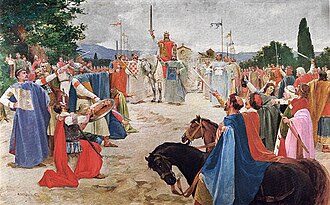
The Croatian people are descended from Slavs who migrated into the region during the sixth and seventh centuries CE and mingled with the existing Latinized population.[12] The Croatians were at the frontiers of Eastern Orthodoxy and Catholicism, and the two churches competed to win them over. In the ninth century, the Catholics succeeded, and the Pope recognized Duke Branimir of Croatia as a rightful Catholic ruler in 879 CE.[13] The Croatians fought centuries of wars against the Italian city-state of Venice, which was a trading power that wanted to turn the Croatian coastline into a series of outposts to control trade.[14] In fact, these wars helped shape the Crusades. In the Fourth Crusade, Venice paid the Crusaders to attack the Croatian city of Zara, turning a holy war into a base mercenary action against a fellow Catholic realm.[15]
The legendary king Tomislav of Croatia became its first great ruler in 925 CE, and his reign saw Croatia become a regional power.[16] His reign was also marked by disputes with the church over whether it would be okay to allow the use of the Slavic language in the liturgy. The church denied him in no uncertain terms. His successors tore the country apart due to the litany of inevitable succession wars caused by the feudal monarchy. The ruling Trpimirović dynasty finally managed to war itself out of existence in 1091 with the death of King Stephen II.[17]
Hungarian rule[edit]

Unfortunately for Croatia, the Trpimirović dynasty had marriage links with the Kingdom of Hungary, and the second-to-last king of Croatia was the brother-in-law of Ladislaus I of Hungary.[18] Ladislaus I claimed the Croatian throne and declared war, beginning a long war over his personal ambitions. The war continued until Ladislaus' successor brought it home in 1097 and finally secured the Croatian throne.[19]
Still, Croatia remained a separate state from Hungary, although it had the Hungarian king on its throne. Those familiar with Europa Universalis will know this arrangement as a personal union.[20] Croatia thus had its own institutions, like the Sabor (an assembly of Croatian nobles) and the ban (a viceroy now appointed by the Hungarian king).[12]
Croatia and Hungary then suffered a series of attacks from the Byzantine Empire, the Mongols, and the Ottoman Empire, all of whom wanted to control the Dalmatian coastline. This led to a slow grinding of Hungarian strength and culminated with the disastrous Battle of Mohács against the Turks in 1526, killing Hungary's King Louis II and completely destroying the monarchy.[21]
Hapsburg rule[edit]
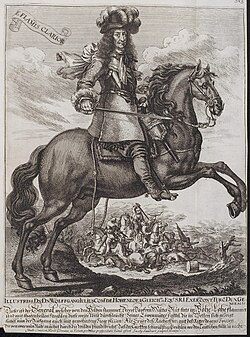
After Hungary got its shit pushed in at Mohács, the Hapsburg dynasty of Austria used marriage ties as a reason to seat the Austrian archduke on Hungary's throne as well. Just to keep it warm. Croatia remained a kingdom, but in light of the Ottoman threat, the Hapsburgs carved out the border areas and placed them under the direct Crown rule as the Croatian Military Frontier.[22] In exchange for extensive land rights and religious freedom in the military region, citizens living in the area had to serve in the military between the ages of 16 and 66.[23] That seems like a raw deal by today's standards, but the rights offered were hard to come by in that era, and guaranteed gainful employment wasn't worth turning down. These benefits offered by the Military Frontier drew immigrants from other parts of the Austrian empire, significantly altering the ethnic landscape of Croatia by introducing Germanic, Serb, and Magyar populations.[24]

With the rise of Hapsburg authority in the region, the Ottoman Empire suffered its first significant defeat on land in 1593 on Croatian soil.[25] With their extensive military training, many Croatians became formidable soldiers, especially cavalrymen.[6] They were especially notable during the Thirty Years' War. They were respected for their skill and fearsomeness but also hated and feared for the savagery they inflicted on civilian populations.[26] The cravats they wore on their necks during this war left an impression on everyone they met, and they eventually evolved into the modern necktie.[27]
Thanks to its military importance, Croatia got significant political rights from the Hapsburg administration, including the right to form its own regional parliament. This regional parliament proved exceptionally loyal to the Hapsburg throne, further enhancing its standing and authority.[28] During the Napoleonic Wars, though, Austrian rule was briefly interrupted when the region was occupied by France. The ideals of the French Revolution spread quickly in Croatia, especially the concept of nationalism.[29] Croats were further angered during the nineteenth century when the Hapsburgs implemented reforms to attempt to Germanize the empire's minority subjects.
Hungary was also resentful toward Austria for this and rebelled in 1848. Fearing the Hungarians more than the Austrians, the Croatians remained loyal to the Hapsburg crown. Still, they felt betrayed when their essential aid went unrewarded, and the harsh suppression of minority populations continued.[29] Having been stabbed in the back by the Hapsburgs, the Croatians steamed in resentment until World War I. Despite that, Croatians in Austria remained loyal during the war due to the fear of Italy's plans to conquer Dalmatia; Croatians living abroad were much less loyal and lobbied the Entente powers for support in creating a Croatian state.[30]
In Yugoslavia[edit]
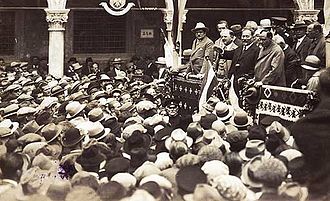
Political tensions[edit]
The Croatian parliament declared independence in 1918 and soon joined the newly-formed South Slavic nation created by Serbia from the ashes of the war.[31] The Croatians, who had helped advocate for Yugoslavia, had been left with the impression that it would be a relatively loose federation that would preserve Croatia's historic levels of autonomy. This became the view of the dominant Croatian Peasant Party.[32] The Serbs, on the other hand, represented by their king and by the Serbian Radical Party, wanted a nation where all powers were invested in the central government in Belgrade. This disagreement wrecked the Yugoslavia project from the very beginning.
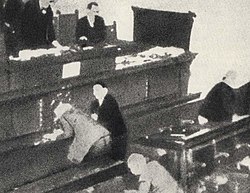
Croatian political leader Stjepan Radić led his party into attempting to sabotage Yugoslavia as a whole by winning seats in the Belgrade parliament and then refusing to fill them.[32] He also traveled around Europe to win international support for Croatian autonomy, even visiting the world's pariah state, the Soviet Union. By 1924, the Serbs were sick of his shit and threatened to have him arrested for sedition. The threat worked briefly, but threats didn't do much to win loyalty, and the Croatians were back to obstructionism by 1926.[32]
The Serbians' hatred for Radić grew worse, and Serbian publications openly called for his death.[33] This finally resulted in bloodshed when Serbian Radical Party MP Puriša Račić brought a gun to parliament and shot wildly at the Croatian delegation, killing Radić and two other MPs.[34] Goddamn.
After the assassination, the Croatian people popped a blood vessel with absolute rage. Shortly afterward, King Aleksandar abolished political parties and established a royal dictatorship.[33] Now way more radical than before, Croatians started to rally behind a new movement, the Ustaše, which called for Croatian independence and revenge against the Serbs. The movement gained support throughout 1929 and became a major force in Croatian politics.
This was gonna go great.
World War II and genocide[edit]

At the outbreak of World War II, the Serbs in Yugoslavia were overwhelmingly pro-Allied, while the non-Serbs went the other way and favored the Axis.[35] Yugoslavia's careful neutrality was broken when Serbs launched a coup against the government and declared hostility against the Axis. In retaliation, the Axis invaded the fuck out of Yugoslavia in 1941 in a rapid campaign that saw Yugoslavia go down in just ten days, thanks to poor national unity and a weak military.[36] The Axis partners proceeded to rip Yugoslavia apart to suit their territorial goals. Recognizing that many Croats liked him, Adolf Hitler allowed the establishment of a puppet regime called the "Independent" State of Croatia led by Ante Pavelić. The latter was also the leader of the Ustaše.[35] And that's where shit got bad.

Croatia became a horrific dictatorship that began a reign of terror, starting with a decree that made "offending the nation of Croatia" a capital offense and continuing with a series of anti-Semitic laws and laws requiring conversion to Catholicism.[37] Croatian policies went into full force even before the Nazis managed it, and Croatian atrocities against the Serbs became the first attempt at wholesale genocide in the entire war.[38] The Ustaše built 40 concentration camps, the worst being the Jasenovac camp, one of the largest in Europe and sometimes called the "Yugoslav Auschwitz".[37]
Conditions in these camps were just as wretched as in the Nazi concentration camps, and guards cruelly tortured, terrorized, and murdered prisoners at will. Around 30,000 Jews and 340,000 Serbs died in Croatian camps or were deported to die in German camps.[39] Roma were also targeted for genocide. Other Serbs were rounded up and forced to convert to Catholicism under the threat of painful death.[40]
Despite their viciousness, or rather because of it, fascist Croatia contributed almost nothing to the Axis war effort. It was too busy dealing with internal revolts and its own genocide plans. Right-wing Serbians formed Chetnik groups to battle the Croatians, and communists led by Josip Tito formed the bulk of the internal war effort against the Ustaše.[35] Tito benefited greatly from his ideology and the resulting relationship he had with the Soviet Union, who came to his rescue in 1944 and thankfully smashed the Ustaše.
Meanwhile, Pavelić fled to the Vatican City with help from Catholic clergy (of course) and then made his way to Argentina.[41] Luckily, a Serbian assassin caught up to him in 1957 and shot him in the back and collarbone. He survived, fled to Spain, and died slowly in excruciating pain for the next few years.[42] Still, less than the piece of shit deserved.
Tito regime[edit]
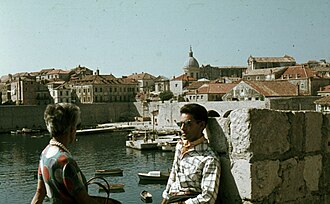
With support from the Soviets, Josip Broz Tito seized control of Yugoslavia and set about turning it into an authoritarian socialist state. He took revenge on the German population living in Yugoslavia by expelling them from the country, although many had lived there since the Hapsburg days.[43] Despite being an ethnic Croat himself, Tito also worked to snuff out expressions of Croatian nationalism. Anyone found guilty of holding nationalist sentiments was denounced as "neo-Ustaše".[44] Still, Croatian national identity and aspirations simmered beneath the surface. Fears of Serbian political dominance and a subsequent attempt to seek revenge for the WWII genocide weighed heavily on many Croatians, and Croatian party leaders pushed for further autonomy from the Tito regime.
Yugoslavia benefited from being able to court foreign aid from both sides in the Cold War. The internal threat of Croatian nationalism caused Tito to crack down harder and harder on internal dissent. The government muzzled the press, arrested dissidents, pressured universities to fire outspoken professors, and redoubled efforts to promote Tito's cult of personality.[44]
Towards disaster again[edit]
Tito died in 1980, and Yugoslavia once again began to spiral on a path toward utter chaos. The economy slumped, and the new government's negotiations for international loans spurred the enactment of policies that saw Croatia lose a further USD$800 million to the central government's finances for debt payments.[45] The new policies, combined with the rise of the hateful nationalist Slobodan Milošević as the new leader of Serbia, made Croatian nationalist rumblings redouble in intensity. Milošević's attempts to push for greater representation for Serbs in the national government terrified Croatians and solidified their resolve to leave Yugoslavia.
War of Independence[edit]
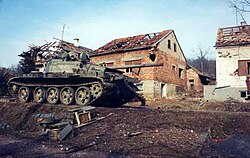
Croatia declared its independence in 1991, almost immediately beginning a civil war against ethnic Serbs living in Croatia who wanted to stay with the rest of Serbia. The Serbian rebels were backed by Milošević, and they seized about a third of Croatia's territory while brutally murdering ethnic Croats.[46] Milošević soon decided that he gave zero shits about preserving Yugoslavia. Instead, he chose to unite ethnic Serbs living in the other Yugoslav republics to create a "Greater Serbia".[47] The horrific destruction the war caused displaced some 220,000 Croats and 300,000 Serbs.[48] Both sides liked to force the unwanted ethnicities out of their homes in the hopes of creating an ethnostate. The terror campaigns and mass slaughter involved in these goals gave rise to the modern term ethnic cleansing. Serbian forces further alienated the international community by shelling the city of Dubrovnik, which is and was a UNESCO World Heritage Site.[49] The European Union quickly slapped sanctions on them.
United States Secretary of State Cyrus Vance helped negotiate a plan for peace that called for the demilitarization of the areas in Croatia under Serbian and Yugoslav control.[50] Unfortunately, Bosnia then declared independence and began the whole shindig again with even worse acts of ethnic cleansing committed by Bosnian Serbs. Croatia entered into an on-again-off-again alliance with the Bosniaks against the Serbs, culminating in 1995 with Operation Storm, which forced the remaining Serb forces out of Croatia while they were distracted with Bosnia.[51] The war ended that year with hundreds of thousands of people displaced and tens of thousands dead.
Reconstruction and reconciliation[edit]
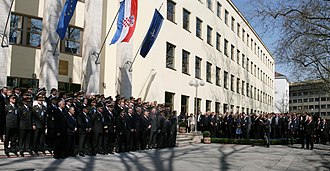
Croatia also came under criticism for its conduct in the war and the closing campaign, especially from the Human Rights Watch, which accused Croatian forces of forcing Serbian civilians out of their homes and then bombarding the refugee columns that the policy created.[52] War rape was also hideously common from both sides in that conflict, and Croatia didn't get around to recognizing that and providing compensation until 2015.[53] Even worse was the displacement crisis in which hundreds of thousands of people were homeless and stateless, combined with the fact that a vast chunk of Croatia's economy had been wrecked. Minefields left behind also remain a severe concern in parts of the country.[54]
For much of the war and its aftermath, Croatian strongman Franjo Tuđman ruled as an authoritarian who used economic controls and censorship to subvert the country's hastily-established democratic system to become a dictator.[55] Luckily, he died in 1999 and losing him as a national symbol allowed a national opposition to see daylight again.
Unfortunately, Croatia still struggles with the problems left behind by the war, like corruption and economic weakness. In 2003, Croatia applied to join the European Union, and negotiations were finalized in 2011.[56] The country also joined NATO in 2009 and participated in the Afghanistan War, the Iraq War, and defense exercises against Russia in the Baltic region.[57]
Government and politics[edit]
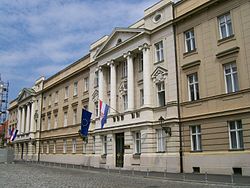
Structure[edit]
Croatia is a unitary parliamentary republic with the typical division between three government branches. Although functioning with a parliamentary system, Croatia also has a president who serves as the head of state and is directly elected to a five-year term.[58] Although holding significant powers, the president is usually less influential than the Prime Minister, who is elected from parliament and serves as the head of government.
The Croatian Parliament, called the Hrvatski Sabor in Croatian, is a unicameral legislature with 151 members.[59] Interestingly, only 140 seats represent constituencies in Croatia; 3 seats are elected by the Croatian diaspora in Bosnia, and 8 seats are reserved for ethnic minorities. MPs serve four-year terms.
Corruption[edit]
Corruption is still a fairly serious problem in Croatia, one left over from the ages of authoritarian rule in Yugoslavia. The problem seems to have only gotten worse despite joining the EU while government leaders are constantly sucked into huge scandals.[60] Observers say the problem starts at the very beginning, with school children taught to cheat on tests.
There is a high risk of encountering corruption in the Croatian judiciary. Bribes in exchange for favorable court rulings are common, and judges are appointed by the government based on politics rather than merit.[61] Businesses in Croatia also frequently provide bribes for favorable access to public services, obtaining construction permits, and securing government licenses.[61] On the plus side, Croatian police generally behave with integrity despite low public opinion.
Genocide denial[edit]
“”Denying that Jasenovac was a death camp makes me feel so bitter. I consider revisionists who claim that kind of thing to be criminals because they are killing victims for the second time with their lies.
|
| —Daniel Ivin, a Jew whose father was murdered in Jasenovac.[62] |
Denial or downplaying the myriad crimes of the Ustaše is sadly common in Croatia. During World War II, Croatia was a puppet state of Nazi Germany that enthusiastically participated in the Holocaust and even widened its scope to target ethnic Serbs and followers of Eastern Orthodoxy. Since 2013, Croatia's politics have shifted towards the right again, and mainstream politicians now frequently deny or "question" the genocidal nature of the Ustaše regime while allowing hate speech laws to go unenforced.[62]
The salute used by the regime, "Za dom spremni" (meaning "for the homeland, ready"), is also widely used for patriotic purposes and at sporting events.[63] Also growing in popularity is the Society for Research of the Threefold Jasenovac Camp, which counts many Catholic clergymen and politicians among its members and aims to paint the concentration camp as a simple labor facility rather than the death machine it really was.[62] What atrocities they acknowledge are blamed on Tito's partisans, a blatantly false narrative. Even Croatian Wikipedia is infested with deniers who push their lies so stubbornly that it has attracted negative international media attention.[64]
Religion[edit]
Croatia's relationship with the Roman Catholic Church is very similar to that of Poland. Around 86% of Croatia's population is nominally Catholic, increasingly lapsed, and very few identify as atheist or non-religious. Many people say that being Croat means being Catholic. Religion was also a major driving force in the 1990s wars.
As in Poland, there is social pressure to follow several church rituals such as baptism, confirmation, and marriage. Public primary and secondary schools (for children aged 6 to 18) include religious education. Taking these classes is not mandatory, but 90% of pupils attend. There are also crucifixes in public school hallways, even though Croatia is officially a secular state.
Abortion, divorce, and homosexuality, though legal, are very much looked down upon by the religious majority.
There are also religious minorities with recognition by the government. In descending order of members are Orthodox Christians, Muslims, Protestant Christians, and Jews.
People[edit]
Who you would like to meet[edit]
- Blanka Vlašić

Who you certainly don't want to meet[edit]
- Alojzije Stepinac

- Igor Vukić
 , journalist and historical negationist who claims that civilians killed in Croatian WWII concentration camps had parties and were playing football matches
, journalist and historical negationist who claims that civilians killed in Croatian WWII concentration camps had parties and were playing football matches - Velimir Bujanec
 , far-right media activist, Nazi supporter, denier of genocide of Jews and Serbs
, far-right media activist, Nazi supporter, denier of genocide of Jews and Serbs
Other[edit]
- Franjo Tuđman
 , deceased war criminal, genocidal maniac and president of Croatia
, deceased war criminal, genocidal maniac and president of Croatia - Slobodan Praljak
 , war criminal, sentenced to 20 years, committed suicide in court
, war criminal, sentenced to 20 years, committed suicide in court
Gallery[edit]
.jpg)
Central Zagreb.
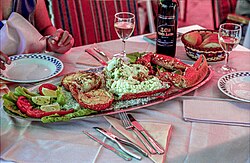
Lobster dish from Dalmatia.
Historic Dubrovnik.
.jpg)
Croatian football fans.
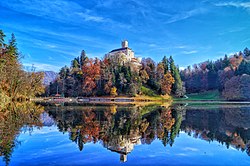
Medieval-era Trakošćan Castle.
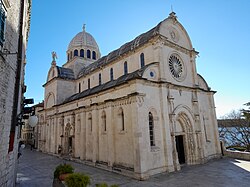
Cathedral of St. James in Šibenik.
Notes[edit]
- ↑ Technically Bosnia has a small 20km coastline near the town of Neum

References[edit]
- ↑ Why Won't Croatia Face Its Past? The New International.
- ↑ See the Wikipedia article on Croatia national football team.
- ↑ Fascist Legacy Causes Persistent Headache for Croatian President. Balkan Insight.
- ↑ Croatia Is Brazenly Attempting to Rewrite its Holocaust Crimes Out of History. Tablet Magazine.
- ↑ See the Wikipedia article on Religion in Croatia.
- ↑ 6.0 6.1 See the Wikipedia article on Croats (military unit).
- ↑ See the Wikipedia article on Illyria.
- ↑ John Wilkes (1995). The Illyrians. Oxford, UK: Wiley-Blackwell. p. 114. ISBN 978-0-631-19807-9.
- ↑ Edward Gibbon; John Bagnell Bury; Daniel J. Boorstin (1995). The Decline and Fall of the Roman Empire. New York: Modern Library. p. 335. ISBN 978-0-679-60148-7.
- ↑ Historical Complex of Split with the Palace of Diocletian. UNESCO.
- ↑ Roman ruins of Salona at Solin. Croatia Traveller.
- ↑ 12.0 12.1 Croatia: History. Britannica.
- ↑ Antun Ivandija (April 1968). "Pokrštenje Hrvata prema najnovijim znanstvenim rezultatima" [Christianization of Croats according to the most recent scientific results]. Bogoslovska Smotra (in Croatian). University of Zagreb, Catholic Faculty of Theology. 37 (3–4): 440–444. ISSN 0352-3101.
- ↑ See the Wikipedia article on Croatian–Venetian wars.
- ↑ See the Wikipedia article on Siege of Zara.
- ↑ See the Wikipedia article on Tomislav of Croatia.
- ↑ See the Wikipedia article on Stephen II of Croatia.
- ↑ Ladislav Heka (October 2008). "Hrvatsko-ugarski odnosi od sredinjega vijeka do nagodbe iz 1868. s posebnim osvrtom na pitanja Slavonije" [Croatian-Hungarian relations from the Middle Ages to the Compromise of 1868, with a special survey of the Slavonian issue]. Scrinia Slavonica (in Croatian). Hrvatski institut za povijest – Podružnica za povijest Slavonije, Srijema i Baranje. 8 (1): 152–173. ISSN 1332-4853.
- ↑ See the Wikipedia article on Battle of Gvozd Mountain.
- ↑ Personal union. Europa Universalis 4 Wiki.
- ↑ Battle of Mohács. Britannica.
- ↑ See the Wikipedia article on Croatian Military Frontier.
- ↑ Ivo Banac; (1984) The National Question in Yugoslavia: Origins, History, Politics p. 43; Cornell University Press, ISBN 0801416752
- ↑ The Croats in the Habsburg Monarchy. World of the Hapsburgs.
- ↑ Frucht, Richard C. (2005). Eastern Europe: An Introduction to the People, Lands, and Culture. ABC-CLIO. ISBN 978-1-57607-800-6. p. 422–423
- ↑ MILITARY LIFE AND WARRIOR IMAGES IN THE CROATIAN BORDER TERRITOY FROM 16th CENTURY TO 1918. Croatian Institute of History.
- ↑ Frucht, Richard C. (2004). Eastern Europe: an introduction to the people, lands, and culture. Vol. 2. ABC-CLIO. ISBN 978-1-57607-800-6. p. 457.
- ↑ See the Wikipedia article on Kingdom of Croatia (Habsburg) § 17th and 18th centuries.
- ↑ 29.0 29.1 Habsburg Croatia. Global Security.
- ↑ Friend or foe? The positions of the southern Slavs in the First World War. World of the Hapsburgs.
- ↑ Tucker, Spencer; Priscilla Mary Roberts (2005). World War I: encyclopedia, Volume 1. ABC-CLIO. p. 1286. ISBN 978-1-85109-420-2.
- ↑ 32.0 32.1 32.2 Croatia in the Kingdom of Yugoslavia. Global Security.
- ↑ 33.0 33.1 Stjepan Radic: His life, his party, his politics. Croatian History.
- ↑ Croatian MPs assassinated in the People’s Assembly: June 20, 1928. YU Historija.
- ↑ 35.0 35.1 35.2 Independent State of Croatia (Nezavisna Drzava Hrvatska, or NDH). Global Security.
- ↑ See the Wikipedia article on Invasion of Yugoslavia.
- ↑ 37.0 37.1 The Forgotten Atrocities of a Fascist Puppet State-Croatia in WW2. War History Online.
- ↑ Phayer, Michael (2000). The Catholic Church and the Holocaust, 1930–1965. Bloomington and Indianapolis: Indiana University Press. ISBN 9780253337252. p. 31.
- ↑ Jasenovac. United States Holocaust Memorial Museum.
- ↑ Yeomans, Rory (2015). The Utopia of Terror: Life and Death in Wartime Croatia. Boydell & Brewer. ISBN 9781580465458. p. 178
- ↑ Breitman, Richard; Goda, Norman J. W.; Naftali, Timothy; Wolfe, Robert (2005). U.S. Intelligence and the Nazis. Cambridge University Press. ISBN 978-0-521-61794-9. p. 215–216.
- ↑ Ante Pavelic, Croatian War Criminal. ThoughtCo.
- ↑ Goldstein, Ivo (1999). Croatia: A History. C. Hurst & Co. ISBN 9781850655251. p. 158
- ↑ 44.0 44.1 Communist Yugoslav Croatia. Global Security.
- ↑ Tanner, Marcus (2001). Croatia : a nation forged in war (2nd ed.). New Haven; London: Yale University Press. ISBN 0-300-09125-7. p. 207
- ↑ Twenty years on, Croatia celebrates end of war as Serbia mourns. Reuters.
- ↑ Serb-Led Presidency Drafts Plan For New and Smaller Yugoslavia. New York Times. December 1991.
- ↑ Zanotti, Laura (2011). Governing Disorder: UN Peace Operations, International Security, and Democratization in the Post-Cold War Era. Penn State Press. ISBN 978-0-271-03761-5. p. 111
- ↑ See the Wikipedia article on Siege of Dubrovnik.
- ↑ See the Wikipedia article on Vance plan.
- ↑ See the Wikipedia article on Operation Storm.
- ↑ IMPUNITY FOR ABUSES COMMITTED DURING "OPERATION STORM". Human Rights Watch.
- ↑ Compensation Comes Late for Rape Survivors of Balkan Wars. Balkan Insight.
- ↑ Soldo S, Puntarić D, Petrovicki Z, Prgomet D (February 1999). "Injuries caused by antipersonnel mines in Croatian Army soldiers on the East Slavonia front during the 1991–1992 war in Croatia". Military Medicine. 164 (2): 141–4. doi:10.1093/milmed/164.2.141. PMID 10050574.
- ↑ Croatia Period of democratic transition: 1999–2000. Freedom house.
- ↑ European Neighbourhood Policy And Enlargement Negotiations: Croatia.
- ↑ Croatia Marks 10 Years of NATO Membership. Total Croatia News.
- ↑ See the Wikipedia article on President of Croatia.
- ↑ See the Wikipedia article on Croatian Parliament.
- ↑ Croatia Seen Backsliding on Corruption since EU Accession. Balkan Insight.
- ↑ 61.0 61.1 Corruption in Croatia. GAN Integrity.
- ↑ 62.0 62.1 62.2 Selective Amnesia: Croatia’s Holocaust Deniers. Balkan Insight.
- ↑ Croatia national team player leads fans in controversial salute: Patriotism, or hate speech? SB Nation.
- ↑ See the Wikipedia article on Denial of genocide of Serbs in the Independent State of Croatia § Croatian Wikipedia.
Categories: [European countries] [Genocide] [Genocide denial] [Member states of the European Union] [NATO member states] [Holocaust]
↧ Download as ZWI file | Last modified: 11/07/2025 20:05:55 | 95 views
☰ Source: https://rationalwiki.org/wiki/Croatia | License: CC BY-SA 3.0

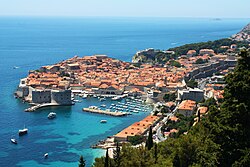
 KSF
KSF